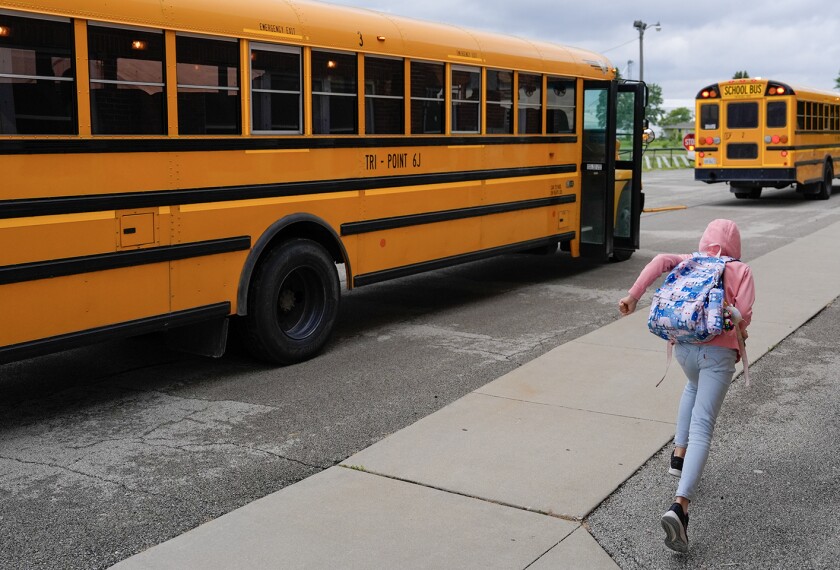Districts are rushing to commit their remaining shares of $800 million in one-time federal aid for homeless students before a September deadline, working with advocacy groups to identify their most pressing priorities.
Districts have until Sept. 30 to obligate those funds, which must be spent by Jan. 31, 2025, unless their state applies for an extended liquidation waiver, which would give administrators until March 2026 to spend money they’ve committed to purposes like ongoing vendor contracts.
The aid, provided as part of the 2021 American Rescue Plan Act, gave schools needed resources to identify students experiencing homelessness and to address barriers to attendance, engagement, and academic success, advocates said. Congress provided the funding in addition to nearly $190 billion in general K-12 aid known as ESSER—Elementary and Secondary School Emergency Relief..
“There is real urgency to maximize the use of these funds for children who have very significant needs,” said Barbara Duffield, executive director of SchoolHouse Connection, an organization that advocates for students experiencing homelessness. “We know that the numbers [of homeless students] are going to show an increase. Homelessness is actually higher now than it was before the pandemic.”
As of Aug. 1, about 43 percent of the targeted funding had not been spent, according to the most recent federal data, which may not account for all of the aid that has been committed due to lags in reporting.
An unprecedented surge in aid
The COVID-related aid is about six times higher than the typical annual appropriation for the federal McKinney-Vento Education for Homeless Children and Youth Program, and it reached schools that don’t receive that targeted funding in a typical year.
Despite great need, some districts have not yet used all of the funds due to delays in federal guidance about acceptable uses and logistical challenges in obligating it, especially in those school systems without robust existing programs for students experiencing homelessness.
“McKinney only reaches 1 in 5 school districts, and this is getting to over half of school districts,” Duffield said. “So you had districts who were getting the funds where, in some ways, it was like starting a whole new program because they’d never had them before.”
The spending deadline approaches as federal data show a continued increase in numbers of students experiencing homelessness, which includes students who are “doubled up” in houses with other families, sleeping on couches or in motels, or in other temporary arrangements. Public schools enrolled 1.2 million homeless students in the 2021-22 school year, the data show. That’s a little more than 2 percent of students.
Families may not realize their temporary housing arrangement qualifies them as homeless or that their children are eligible for additional services and supports. Typically, schools use McKinney-Vento funding to pay for coordinators who help identify those families, connect them to community supports, and provide things like school supplies, shoes, laundry tokens, and bus passes to help students attend school.
In addition to those uses, federal officials gave schools the freedom to spend the emergency aid on a broader array of expenses, like covering unexpected car repairs so parents can continue driving their children to school, providing internet hotspots to allow students to do homework without home internet access, and paying for the occasional emergency, short-term motel stay when families have no other safe option.
“A relevant consideration regarding ‘short-term’ might include ensuring a student can complete a week of school before a housing change,” the U.S. Department of Education said in a September 2023 letter.
Advocates have pressed Congress to allow schools to apply those same flexibilities to their ongoing aid for homeless programs after the one-time COVID-related funds expire. They are also racing to help administrators meet the September spending deadline so that they can spend the unprecedented surge wisely, Duffield said.
Schools use aid for bus passes and counseling contracts
With proper documentation, districts can use their share of funding to pay for grocery store gift cards, bus passes, and laundry tokens that can be distributed and used even after the liquidation deadline, SchoolHouse Connection said in recent guidance.
That guidance outlines low-, medium-, and higher-cost options for a range of spending priorities. Among the recommendations:
- To help students with transportation, schools could consider gas cards to help families, bikes for students, or contracts with bus services.
- To help identify students, schools could use funds to print posters, provide staff training, or contract with community organizations to help with outreach.
- To help with technology, schools could pay for everything from prepaid phone cards to creating spaces for families to use the internet after school hours.
- To improve training and staff capacity, districts could pay stipends for professional development, pay conference registration fees, or contract with vendors to assess their current offerings for homeless students and determine how to improve their programs and coordination with outside agencies.
- To provide families with needed supplies, schools can stock up on items like feminine hygiene products, clothing, and in-school washers and dryers for student laundry.
- Funds can also be used for academic supports like tutoring, fees for dual-enrollment programs, and contracts with community organizations to provide services like counseling.
“We’ve got 60 days to really pay close attention to what the needs of students are and to make sure these funds get used to help them,” Duffield said.
Disclaimer: The copyright of this article belongs to the original author. Reposting this article is solely for the purpose of information dissemination and does not constitute any investment advice. If there is any infringement, please contact us immediately. We will make corrections or deletions as necessary. Thank you.







